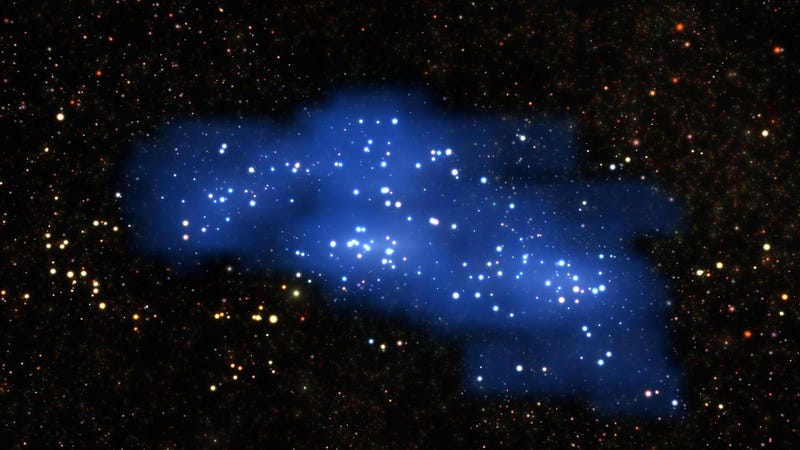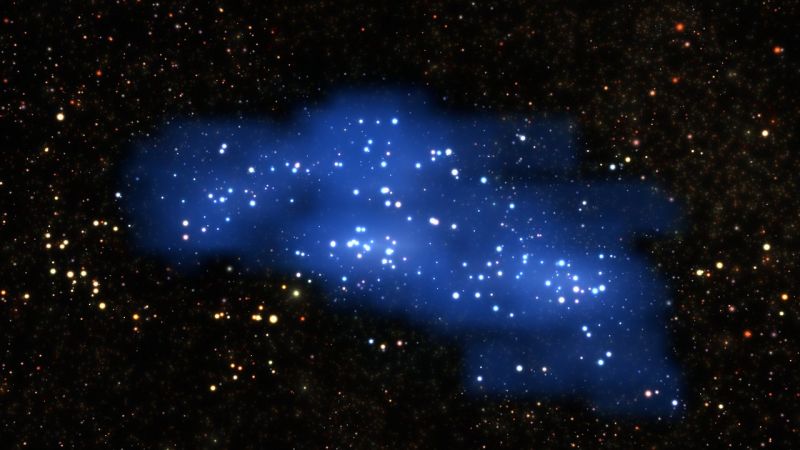
Light’s speed limit means that looking into the distance is the same as looking into the past: The farther incoming light travels, the older it is. Out in the distance, scientists have spotted a truly enormous, ancient “proto-supercluster,” dubbed Hyperion, which could help explain how the universe forms some of its largest structures.
Hyperion is the largest structure discovered so far at this distance, 2 billion years after the Big Bang. It could potentially offer scientists a unique tool to study superclusters—clusters of clusters of galaxies—while they form. The astronomers who authored a new study published in Astronomy and Astrophysics thought it was quite exciting.
Advertisement
“It’s a surprise to see that gravity had the time to build such a huge thing considering that the universe was only roughly two billion years old,” study authorOlga Cucciati from the Istituto Nazionale di Astrofisica in Italy told Gizmodo. “The bigger the structure is, the more time it takes to put it together.”
The universe seems to take on a web structure, with enormous voids separated by filaments of galaxies, and clusters of galaxies connected via gravity. Scientists have named even larger structures, places with an overabundance of galaxy clusters (though not necessarily strongly bound by gravity themselves) called superclusters. The Milky Way lives in a cluster of galaxies called the local group, which would be part of the Virgo Supercluster, itself perhaps part of a larger supercluster called the Laniakea Supercluster.
Scientists spotted Hyperion by looking for dense spots in the in the VIMOS Ultra Deep Survey, which measures the light and distance for around 10,00 objects, including 5,000 confirmed galaxies, using the European Southern Observatory’s Very Large Telescope. They performed a search for structures, and found seven related complex grouping of galaxies 200 million light years by 200 million light years by 490 million light years, with an estimated mass 4.8 quadrillion times the mass of the Sun, or 10,000 times heavier than the Milky Way.
Advertisement
This is perhaps the same size as our Laniakea supercluster, but Laniakea would be a hundred times heavier than Hyperion. If a fighter jet tried to fly approximately 500 million light years, it would take from now until the last of the universe’s stars die out (not counting star corpses like black holes, neutron stars, and white dwarfs).
Others also thought the paper was cool. “It’s an interesting piece of work, using coherent data sets to try to build up a more contextual sense of what’s going on in this patch of sky,” Jillian Scudder, an assistant professor and astronomer at Oberlin College, told Gizmodo. She cautioned that further observations might change the determined shape of the region. Scudder points out that whether or not parts of the region are considered an “overdensity” of galaxies can change based on the statistical analysis.
The researchers were especially excited about the clear detection of structures within this enormous region of space, and hope to follow up with further analysis, according to the study. They’d also like to compare the cluster to simulations of the standard model of the universe’s evolution, though this would require a better census of Hyperion’s galaxies.
Advertisement
Said Cucciati: “The fun part begins now.”
[AandA]













